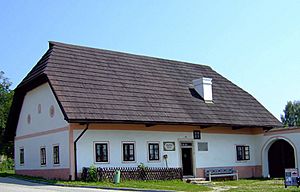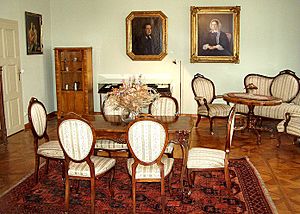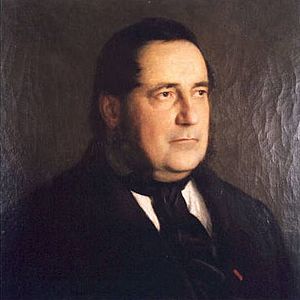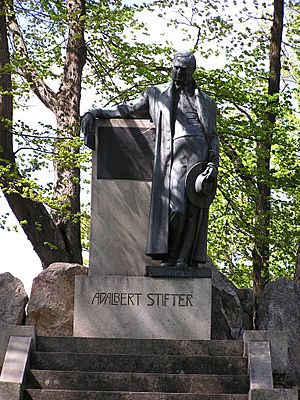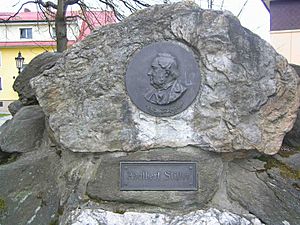Adalbert Stifter facts for kids
Quick facts for kids
Adalbert Stifter
|
|
|---|---|

Stifter
|
|
| Born | 23 October 1805 Oberplan, Bohemia (now Horní Planá, the Czech Republic) |
| Died | 28 January 1868 (aged 62) Linz, Austria-Hungary |
| Resting place | St. Barbara-Friedhof in Linz, Austria |
| Occupation | Novelist, poet, painter, pedagogue |
| Language | German |
| Nationality | Austrian |
| Alma mater | University of Vienna |
| Period | 1830–1868 |
| Genre | Poetic realism |
| Notable works | Bergkristall, Der Nachsommer, Witiko |
| Spouse | Amelia Mohaupt (1837–1868) |
| Signature | |
Adalbert Stifter (German: [ˈʃtɪftɐ]; 23 October 1805 – 28 January 1868) was an Austrian writer, poet, painter, and teacher. He was known for describing nature very clearly and beautifully in his stories. He is still popular in German-speaking countries, but not many English readers know his work.
Contents
Life of Adalbert Stifter
Adalbert Stifter was born in Oberplan, which is now called Horní Planá in the Czech Republic. He was the oldest son of Johann Stifter, a rich linen weaver. His father died in 1817 in an accident.
Stifter went to school at the Benedictine Gymnasium in Kremsmünster. In 1826, he started studying law at the University of Vienna.
In 1828, he met Fanny Greipl and they were together for five years. Her parents did not approve, and they had to stop seeing each other. This was a very sad time for Stifter. In 1835, he got engaged to Amalia Mohaupt, and they married in 1837. Their marriage was not very happy.
Stifter and his wife could not have children. They tried to adopt three of Amalia's nieces at different times. One of them, Juliana, ran away and was later found drowned in the Danube river.
Stifter had strong beliefs in liberal ideas, which meant he supported freedom and individual rights. He even supported the 1848 revolutions, which were a series of protests for more freedom in Europe. He believed strongly in Bildung, which means personal growth and education.
Instead of becoming a government official, he became a tutor for rich families in Vienna. He was a very respected teacher. Some of his students included Princess Maria Anna von Schwarzenberg and Richard Metternich.
Stifter also earned money by selling his paintings. In 1840, he published his first story, "Der Condor," which was an instant success. This started his career as a writer.
In 1848, Stifter visited Linz, Austria. A year later, he moved there permanently. He became an editor for local newspapers. In 1850, he was put in charge of elementary schools for Upper Austria.
His health began to get worse around 1863. He became very ill in 1867. Sadly, he suffered from severe depression and died on January 28, 1868.
Adalbert Stifter's Writing
Stifter's stories often focus on beauty. His characters try to be good and live in beautiful, detailed natural places. You don't often see evil or suffering directly in his writing. However, some writers like Thomas Mann felt that behind the calm descriptions, there was a hint of something wild or powerful.
Stifter's ideas about ideal worlds fit with the Biedermeier movement in literature. This movement focused on simple, peaceful, and cozy home life. He wanted to show his ideas about Bildung (personal growth) through his stories.
Most of his works are long stories or short novels. Many of them were published in different versions over time. His most important novels are Der Nachsommer and Witiko.
Der Nachsommer (published in 1857) is seen as one of the best examples of a Bildungsroman. This is a type of novel that tells the story of a character's moral and psychological growth. At first, some critics didn't like it, saying it had too much detail. But today, many scholars find these details fascinating. They believe the many objects and descriptions of nature and art create a rich and beautiful background for the human story.
Witiko is a historical novel set in the 12th century. It tells the story of Witiko of Prčice and the House of Rosenberg. While some critics didn't understand it, famous writers like Hermann Hesse and Thomas Mann praised it.
Influence on Other Writers
Many famous writers and thinkers admired Adalbert Stifter's work.
- W. G. Sebald said Stifter influenced him.
- The poets W. H. Auden and Marianne Moore also liked his stories. Marianne Moore even helped translate his novella Bergkristall into English as Rock Crystal.
- In Hermann Hesse's novel Steppenwolf, the main character thinks about Stifter.
- Thomas Mann called Stifter "one of the most extraordinary, the most enigmatic, the most secretly daring and the most strangely gripping narrators in world literature."
- Other important writers like Rilke and Hugo von Hofmannsthal were also greatly inspired by his art.
Recent Production
In 2007, a German theater director named Heiner Goebbels created a musical installation called Stifters Dinge (Stifter's Things). He was inspired by Adalbert Stifter's works. It first showed in Lausanne, Switzerland.
Works
- Julius (1830)
- Der Condor (3 vols. 1839)
- Feldblumen ("Field Flowers") (1841)
- Das alte Siegel (1844)
- Die Narrenburg (1844)
- Studien (6 vols. 1844–1845)
- Das Haidedorf ("The Village on the Heath") (1840)
- Der Hochwald (1841)
- Abdias (1842)
- Brigitta (1844)
- Der Hagestolz ("The Bachelors") (1845)
- Der Waldsteig (1845)
- Der beschriebene Tännling (1846)
- Der Waldgänger ("The Wanderer in the Forest") (1847)
- Der arme Wohltäter (1848)
- Prokopus (1848)
- Die Schwestern ("The Sisters") (1850)
- Bunte Steine ("Colorful Stones") (2 vols., 1853)
- Granit ("Granite")
- Kalkstein ("Limestone")
- Turmalin ("Tourmaline")
- Bergkristall ("Rock Crystal")
- Katzensilber ("Muscovite")
- Bergmilch ("Moonmilk")
- Der Nachsommer ("Indian Summer") (1857)
- Die Mappe meines Urgrossvaters (1864)
- Nachkommenschaften (1865)
- Witiko (3 vols., 1865–1867) concerning Witiko of Prčice and the House of Rosenberg
- Der Kuß von Sentze (1866)
- Erzählungen ("Tales") (1869)
- Die Mappe meines Urgrossvaters (erster und zweiter Band (unvollendet)) (1939)
Works in translation
- Castle Crazy ; and, Maroshely, tr. unknown 1851.
- Rock Crystal, tr. Lee M. Hollander, 1914.
- Rock Crystal, tr. Elizabeth Mayer and Marianne Moore, 1945. Re-issued by Pushkin Press 2001 and by the New York Review of Books 2008.
- Brigitta, tr. Ilsa Barea, 1960.
- Limestone and Other Stories, Harcourt, Brace & World, tr. David Luke, 1968.
- The Recluse, Jonathan Cape, Cape Editions, tr. David Luke, 1968.
- Indian Summer, Peter Lang, tr. Wendell Frye, 1985.
- Brigitta and Other Tales, Penguin Press, tr. Helen Watanabe-O'Kelly, 1995.
- Witiko, Peter Lang, tr. Wendell Frye, 1999.
- The Bachelors, Pushkin Press, tr. David Bryer, 2009.
- Tales of Old Vienna and Other Prose, Ariadne Press, tr. Alexander Stillmark, 2016.
- Motley Stones, New York Review Books, tr. Isabel Fargo Cole, 2021
See also
 In Spanish: Adalbert Stifter para niños
In Spanish: Adalbert Stifter para niños


